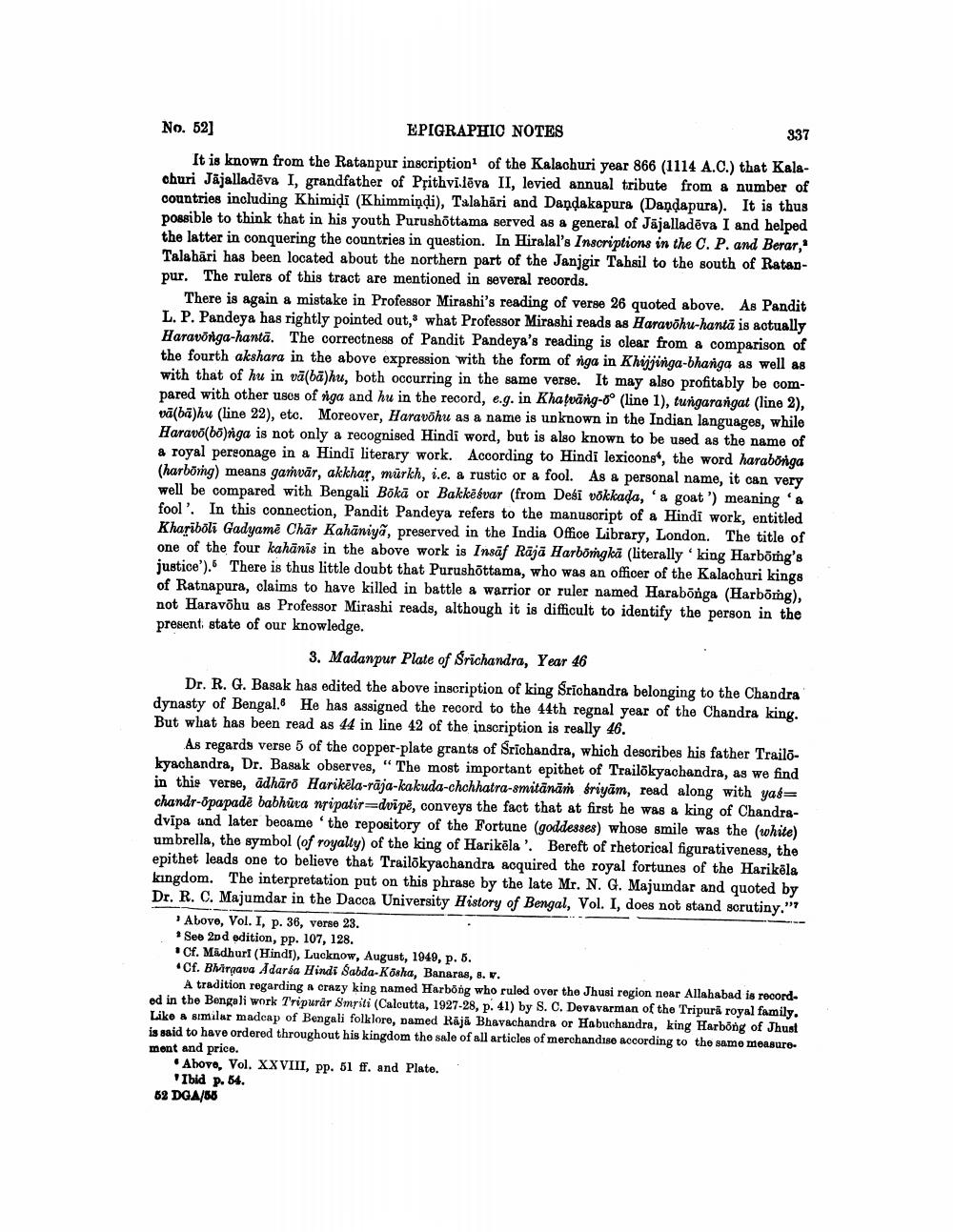________________
No. 52] EPIGRAPHIC NOTES
337 It is known from the Ratanpur inscription of the Kalachuri year 866 (1114 A.C.) that Kalachuri Jājalladēva I, grandfather of Přithvilēva II, levied annual tribute from a number of countries including Khimidi (Khimmiņdi), Talahāri and Dandakapura (Dandapura). It is thus possible to think that in his youth Purushottama served as a general of Jājalladēva I and helped the latter in conquering the countries in question. In Hiralal's Inscriptions in the C. P. and Berar, Talahari has been located about the northern part of the Janjgir Tahsil to the south of Ratanpur. The rulers of this tract are mentioned in several records.
There is again a mistake in Professor Mirashi's reading of verse 26 quoted above. As Pandit L. P. Pandeya has rightly pointed out, what Professor Mirashi reads as Haravöhu-hantā is actually Haravõrga-hantā. The correctness of Pandit Pandeya's reading is clear from & comparison of the fourth akshara in the above expression with the form of nga in Khijjinga-bhanga as well as with that of hu in vā(ba)hu, both occurring in the same verse. It may also profitably be compared with other uses of nga and hu in the record, e.g. in Khatang-8° (line 1), tungarangat (line 2), vā(bā)hu (line 22), etc. Moreover, Haravõhu as a name is unknown in the Indian languages, while Haravo(bo)riga is not only a recognised Hindi word, but is also known to be used as the name of a royal personage in a Hindi literary work. According to Hindi lexicons, the word harabönga (harböring) means ganvār, akkhar, mürkh, i.e. a rustic or a fool. As a personal name, it can very well be compared with Bengali Bökā or Bakkēsvar (from Desi vókkada, & goat') meaning & fool'. In this connection, Pandit Pandeya refers to the manuscript of a Hindi work, entitled Kharibóli Gadyamē Char Kahāniyā, preserved in the India Office Library, London. The title of one of the four kahānis in the above work is Insāf Rājā Harborgkā (literally 'king Harbog's justice'). There is thus little doubt that Purushottama, who was an officer of the Kalachuri kings of Ratnapura, claims to have killed in battle & warrior or ruler named Harabonga (Harborg), not Haravõhu as Professor Mirashi reads, although it is difficult to identify the person in the present state of our knowledge.
3. Madanpur Plate of Śrīchandra, Year 46 Dr. R. G. Basak has edited the above inscription of king Srichandra belonging to the Chandra dynasty of Bengal. He has assigned the record to the 44th regnal year of the Chandra king. But what has been read as 44 in line 42 of the inscription is really 46.
As regards verse 5 of the copper-plate grants of Srichandra, which describes his father Trailokyachandra, Dr. Basak observes, "The most important epithet of Trailokyachandra, as we find in thie verse, adharo Harikēla-rāja-kakuda-chchhatra-smitānām briyām, read along with yas= chandr-Opa pada babhūra nripatir dvipē, conveys the fact that at first he was a king of Chandradvipa und later became the repository of the Fortune (goddesses) whose smile was the (white) umbrella, the symbol (of royalty) of the king of Harikēla'. Bereft of rhetorical figurativeness, the epithet leads one to believe that Trailokyachandra acquired the royal fortunes of the Harikēla kingdom. The interpretation put on this phrase by the late Mr. N. G. Majumdar and quoted by Dr. R. C. Majumdar in the Dacca University History of Bengal, Vol. I, does not stand sorutiny."
Above, Vol. I, p. 36, verse 23. * Seo 20d edition, pp. 107, 128. *Cf. Madhurl (Hindi), Lucknow, August, 1949, p. 5. .Of. Blirnava Adaria Hindi Sabda-Kösha, Banaras, 8. v.
A tradition regarding a crazy king named Harbong who ruled over the Jhusi region near Allahabad is record. ed in the Bengali work Tripurar Smriti (Calcutta, 1927-28, p. 41) by S. C. Devavarman of the Tripura royal family. Like a similar madeap of Bengali folklore, named Rājā Bhavachandra or Habuchandra, king Harbong of Jhust is said to have ordered throughout his kingdom the sale of all articles of merchandise according to the same measure. ment and price.
• Ahovo, Vol. XXVIII, PP. 51 ff. and Plate.
Ibid p. 54. 62 DGA/88




